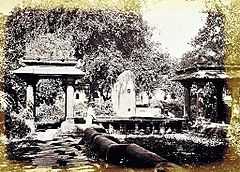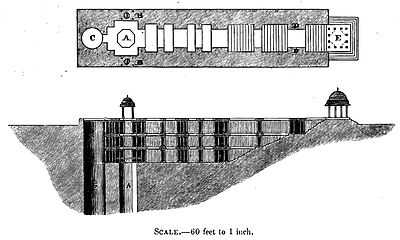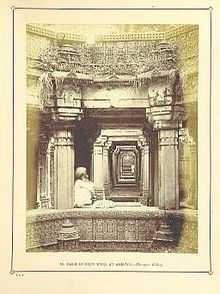Dada Harir Stepwell
| Dada Harir Stepwell | |
|---|---|
 Cupola over staircases – Dada Harir Stepwell, 1866 | |
 Location within Gujarat | |
| General information | |
| Architectural style | Hindu and Islamic architecture |
| Town or city | Ahmedabad |
| Country | India |
| Coordinates | 23°02′25″N 72°36′19″E / 23.0402692°N 72.605416°E |
| Construction started | 1485 |
| Completed | 15th century |
| Technical details | |
| Floor count | Five storied stepwell |
| Design and construction | |
| Architect | Local |
| Designations |
Monument of National Importance ASI Monument No. N-GJ-18 |
Dada Harir Stepwell (Gujarati: દાદા હરિર વાવ, Hindi: दादा हरीर बावड़ी, Marathi: दादा हरीर बारव) is a stepwell in Asarwa area of Ahmedabad, Gujarat, India.
History
The stepwell was built in 1485 by Muslim king Sultan Bai Harir. A Sanskrit inscription at Dada Hari ni Vav says that the seven-storey step-well was built in 1500 AD. It was during the reign of Mahmud Shah that Bai Harir Sultani, locally known as Dada Hari, built the step-well. Sultani was the superintendent of the royal harem. The building, with beautiful carvings all over, cost 3,29,000 Mahmudis (more than Rs1 lakh) at that time. The ornate step-well has spiral staircases pieced into the sidewall of the well shaft and descending to the different platform levels.[1][2]
Structure


Built in sand stone in Solanki architectural style, the Dada Harir stepwell is five stories deep. It is octagonal (9-sided polygon) in plan at the top, built on intricately carved large number of pillars. Each floor is spacious enough to provide for people to congregate. It was dug deep to access ground water at that level, accounting for seasonal fluctuations in water level due to rainfall over the year. The air and light vents in the roofs at various floors and at the landing level are in the form of large openings. From the first story level, three staircases lead to the bottom water level of the well, which is considered a unique feature.
Built along a North-South axis, entrance is from the South, the three staircases are from the South, West and East directions leading to the landing, which is on the northern side of the well. The structural system is typically Indian style with traditional trabeat with horizontal beams and lintels. At the bottom of the well is a square stepped floor in the shape of a funnel extending to the lowest plane. This is chiseled into a circular well. Above the square floor, columns, beams, wall and arched openings spiral around; a feature that continues to the top. The top part of the well, however, is a vertical space open to the sky. The four corners of the square are strengthened with stone beams, set at 45 degrees angle. The motifs of flowers and graphics of Islamic architecture blend very well with the symbols of Hindu and Jain gods carved at various levels of the well. The dominant carvings on the upper floors are of elephants (3 inches (76 mm) in size, each of different design). The Islamic architectural style could be attributed to the Muslim king Sultan Bai Harir who built it.
The temperature inside the well is said to be about five degrees lower than the outside hot summer temperatures. This encouraged the women who came to fetch water to spend more time in the cool climes here. They stayed to worship the gods and goddesses and gossip. A tribute paid to the rich underground structures, which are intricately decorated with sculptures, is that they are said to resemble palaces.
Gallery
-
-
-
-
-
-
-
-
Stepwell staircase
See also
References
- ↑ Gazetteer of the Bombay Presidency: Ahmedabad. Government Central Press. 1879. p. 282.
- ↑ Rajan, Soundara (27 November 2009). "Bad times for Dada Hari ni Vav in Gujarat". Retrieved 14 December 2014.
| Wikimedia Commons has media related to Dada Harir Stepwell. |







